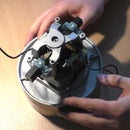Introduction: Hand Made Aluminium T-Nuts
Many router tables and other pieces of fixed workshop equipment have a t-tack or t-slot in the table into which you can fit a t-nut. The t-nut is used to hold down other pieces of equipment such as feather boards and various jigs. In this Instructable I make some t-nuts for the t-track I fitted in my router table.
Let me first say that I don’t know whether this project should necessarily inspire you or act as a warning. Nothing went wrong and the end product is great but it was hard work because I only have woodworking tools. What this project shows is that with a little determination and some lateral thinking woodworkers can do some metalwork.
This project along with loads of others is also available on Wobblycogs Workshop.
Materials
- 10mm aluminium sheet. Grade doesn't matter. Size depends on how many t-nuts you want to make.
Tools
The tools list below are what I used. You could complete this project a lot more easily with a milling machine.
- Mitre saw
- Chisel
- Files - needle files were the most useful
- Belt sander
- Sand paper
- Drill
- M5 Tap
Step 1: Cut the T-Nut Blank
The first thing you need to do is cut a long blank of t-nuts. It's much easier to make a row that will be cut up later than to try and make one at a time.
Lubricate the aluminium thoroughly before each cut and then square up the edge of the aluminium. Cut a shoulder along the squared up edge, this creates one side of the T shape. Move the material across in the saw the width of the top opening of the t-track and cut another shoulder. Move the material across again and cut the t-nut blank free at the width of the bottom of the t-track.
When cutting the blank free don't cut all the way to the end as there's a danger the blank will go flying, instead clamp the material to the workbench and use a hacksaw to finish the cut. You now have a very long t-nut.
Step 2: Test Fit and Clean Up the Shoulder
Test fit the t-nut blank in the t-track. I found that the width was good but the height of the shoulders was a bit off - they were slightly too tall.
When trench cutting on the mitre saw the saw is unable to cut right to the fence and this leaves a small amount of material on the shoulder at one end. I initially tried to clean this up with my large blunt file but after five minutes of working hard and achieving nothing I switched to plan B. Plan B was to use one of my old but sharp chisels to chisel the waste away, surprisingly this worked very well. Once I'd removed most of the waste I used a small file to clean up the shoulders.
Step 3: Reduce to Thickness and Clean Up
As mentioned earlier the shoulders were a little too tall to got into the t-track and the easiest way to reduce them was to reduce the thickness of the whole blank by sanding the bottom of the t-nut (e.g. so the nut sat deeper in the track). This was easily done using a belt sander with an 80 grit belt. The edges of the t-nut blank were too delicate to be finished with the belt sander so I quickly made a lap and lapped the edges taking care to knock off any sharp corners. Sand until the whole blank will fit into the track.
Step 4: Divide Up and Clean Up
Divide the t-nut blank up into reasonable sized nuts. I found the width of my steel ruler (about 25mm) was a good size and it gave me eight nuts which should be enough to keep me going for a while. Use a hacksaw to cut the blank into pieces and then clean up the cut edges on the lap.
You could try cleaning up the cut edges on the belt sander but I found the pieces hard to hold onto because they are small and they heat up quickly.
Step 5: Mark, Drill and Tap
Find the centre of the t-nuts by drawing a line from corner to corner and then drill and tap them. I found that M5 was a good thread size for these nuts as it gave a reasonable number of threads in the nut. If you required a larger bolt I think M6 would also work well.




